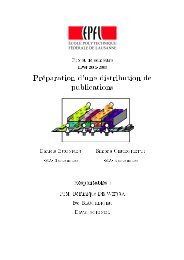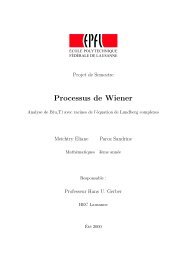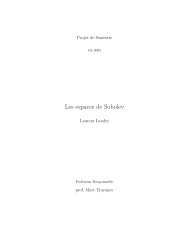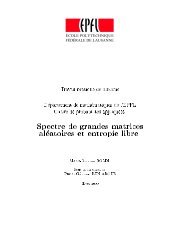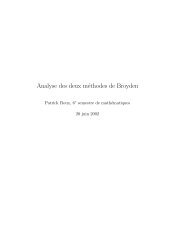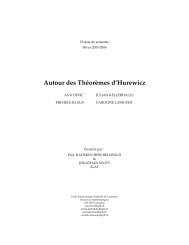Identification du dual topologique de C[a, b] Louis ... - CQFD - EPFL
Identification du dual topologique de C[a, b] Louis ... - CQFD - EPFL
Identification du dual topologique de C[a, b] Louis ... - CQFD - EPFL
You also want an ePaper? Increase the reach of your titles
YUMPU automatically turns print PDFs into web optimized ePapers that Google loves.
et donc<br />
1. NOTIONS PRELIMINAIRES 7<br />
n∑<br />
|f(x j ) − f(x j−1 )| ≤ K<br />
j=1<br />
Remarque 1.11. Nous énonçons ci-<strong>de</strong>ssous quelques résultats utilisés<br />
dans certaines démonstrations au chapitre suivant :<br />
Proposition 1.4. Soit f ∈ R [a,c]<br />
– Si f ∈ BV [a, c] et a < b < c, alors : V c<br />
a (f) = V b<br />
a (f) + V c<br />
b (f)<br />
– Si f |[a,b] ∈ BV [a, b] et f |[b,c] ∈ BV [b, c], alors f ∈ BV [a, c]<br />
Alors :<br />
Proposition 1.5. Soit f ∈ BV [a, b]. On définit :<br />
π(a) = 0 et π(x) := V x<br />
a (f), ∀x ∈ (a.b]<br />
– π ≥ 0 sur [a, b]<br />
– π est croissante sur [a, b]<br />
– Soit c ∈ [a, b], alors f est continue en c ⇔ π est continue en c<br />
Théorème 1.12. Jordan<br />
Toute fonction continue à variation bornée peut s’écrire comme différence<br />
<strong>de</strong> <strong>de</strong>ux fonctions continues monotones croissantes.<br />
Théorème 1.13. Premier Théorème d’Helly<br />
Soit une collection quelconque <strong>de</strong> fonctions F ⊂ R [a,b] .<br />
Si ∃K > 0 tel que<br />
|f| ≤ K et V b<br />
a (f) ≤ K , ∀f ∈ F<br />
alors il existe une suite {f n } n∈N ⊂ F qui converge en chaque point <strong>de</strong> [a, b]<br />
vers une fonction ϕ ∈ BV [a, b].<br />
Définition 1.14. Soit f ∈ R [0,1] . On appelle polynome <strong>de</strong> Bernstein <strong>de</strong><br />
<strong>de</strong>gré n <strong>de</strong> la fonction f la fonction :<br />
n∑ ( i<br />
B n (x) := f C<br />
n)<br />
nx i i (1 − x) n−i , ∀x ∈ [0, 1]<br />
où<br />
i=0<br />
C i n :=<br />
n!<br />
(n − i)! i! , i = 0, . . . , n<br />
Théorème 1.15. Bernstein<br />
Si f ∈ C[0, 1], alors ‖B n − f‖ −→ 0 quand n → ∞


![Identification du dual topologique de C[a, b] Louis ... - CQFD - EPFL](https://img.yumpu.com/32808525/7/500x640/identification-du-dual-topologique-de-ca-b-louis-cqfd-epfl.jpg)

